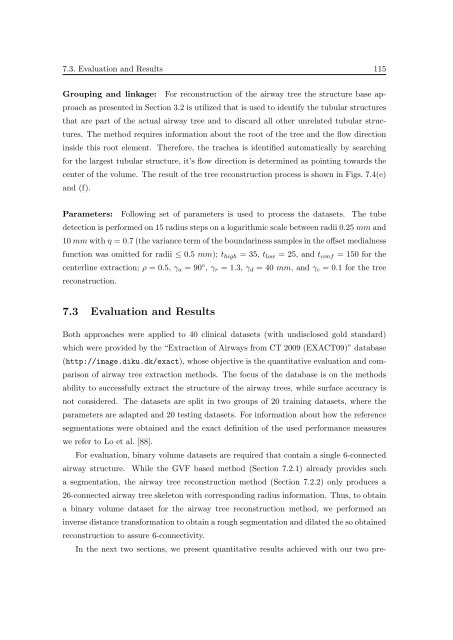Segmentation of 3D Tubular Tree Structures in Medical Images ...
Segmentation of 3D Tubular Tree Structures in Medical Images ...
Segmentation of 3D Tubular Tree Structures in Medical Images ...
Create successful ePaper yourself
Turn your PDF publications into a flip-book with our unique Google optimized e-Paper software.
7.3. Evaluation and Results 115<br />
Group<strong>in</strong>g and l<strong>in</strong>kage: For reconstruction <strong>of</strong> the airway tree the structure base approach<br />
as presented <strong>in</strong> Section 3.2 is utilized that is used to identify the tubular structures<br />
that are part <strong>of</strong> the actual airway tree and to discard all other unrelated tubular structures.<br />
The method requires <strong>in</strong>formation about the root <strong>of</strong> the tree and the flow direction<br />
<strong>in</strong>side this root element. Therefore, the trachea is identified automatically by search<strong>in</strong>g<br />
for the largest tubular structure, it’s flow direction is determ<strong>in</strong>ed as po<strong>in</strong>t<strong>in</strong>g towards the<br />
center <strong>of</strong> the volume. The result <strong>of</strong> the tree reconstruction process is shown <strong>in</strong> Figs. 7.4(e)<br />
and (f).<br />
Parameters: Follow<strong>in</strong>g set <strong>of</strong> parameters is used to process the datasets. The tube<br />
detection is performed on 15 radius steps on a logarithmic scale between radii 0.25 mm and<br />
10 mm with η = 0.7 (the variance term <strong>of</strong> the boundar<strong>in</strong>ess samples <strong>in</strong> the <strong>of</strong>fset medialness<br />
function was omitted for radii ≤ 0.5 mm); t high = 35, t low = 25, and t conf = 150 for the<br />
centerl<strong>in</strong>e extraction; ρ = 0.5, γ a = 90 ◦ , γ r = 1.3, γ d = 40 mm, and γ c = 0.1 for the tree<br />
reconstruction.<br />
7.3 Evaluation and Results<br />
Both approaches were applied to 40 cl<strong>in</strong>ical datasets (with undisclosed gold standard)<br />
which were provided by the “Extraction <strong>of</strong> Airways from CT 2009 (EXACT09)” database<br />
(http://image.diku.dk/exact), whose objective is the quantitative evaluation and comparison<br />
<strong>of</strong> airway tree extraction methods. The focus <strong>of</strong> the database is on the methods<br />
ability to successfully extract the structure <strong>of</strong> the airway trees, while surface accuracy is<br />
not considered. The datasets are split <strong>in</strong> two groups <strong>of</strong> 20 tra<strong>in</strong><strong>in</strong>g datasets, where the<br />
parameters are adapted and 20 test<strong>in</strong>g datasets. For <strong>in</strong>formation about how the reference<br />
segmentations were obta<strong>in</strong>ed and the exact def<strong>in</strong>ition <strong>of</strong> the used performance measures<br />
we refer to Lo et al. [88].<br />
For evaluation, b<strong>in</strong>ary volume datasets are required that conta<strong>in</strong> a s<strong>in</strong>gle 6-connected<br />
airway structure. While the GVF based method (Section 7.2.1) already provides such<br />
a segmentation, the airway tree reconstruction method (Section 7.2.2) only produces a<br />
26-connected airway tree skeleton with correspond<strong>in</strong>g radius <strong>in</strong>formation. Thus, to obta<strong>in</strong><br />
a b<strong>in</strong>ary volume dataset for the airway tree reconstruction method, we performed an<br />
<strong>in</strong>verse distance transformation to obta<strong>in</strong> a rough segmentation and dilated the so obta<strong>in</strong>ed<br />
reconstruction to assure 6-connectivity.<br />
In the next two sections, we present quantitative results achieved with our two pre-















